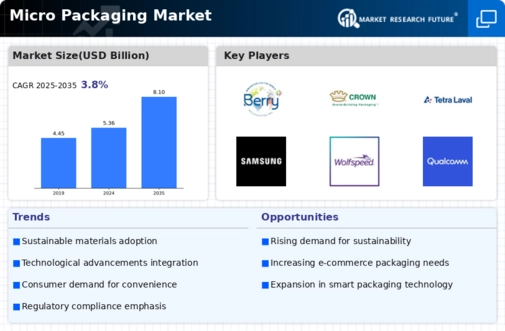Market Growth Projections
The Global Micro Packaging Market Industry is poised for substantial growth over the coming years. Projections indicate that the market will reach a value of 5.36 USD Billion in 2024, with further expansion expected to 8.1 USD Billion by 2035. This growth trajectory suggests a compound annual growth rate (CAGR) of 3.82% from 2025 to 2035. Such figures highlight the increasing relevance of micro packaging solutions across various sectors, including food and beverage, pharmaceuticals, and consumer goods. The anticipated growth reflects not only the rising demand for innovative packaging solutions but also the industry's adaptability to evolving consumer needs and regulatory landscapes.
Growth of E-commerce and Online Retail
The rapid expansion of e-commerce and online retail significantly influences the Global Micro Packaging Market Industry. As more consumers turn to online shopping, the demand for efficient and protective packaging solutions intensifies. Micro packaging offers the advantage of lightweight and compact designs, which are essential for reducing shipping costs and enhancing the customer experience. Companies are increasingly adopting micro packaging to ensure that products arrive safely and in optimal condition. This trend is expected to drive the market's growth, with forecasts suggesting a market value of 8.1 USD Billion by 2035, underscoring the critical role of e-commerce in shaping packaging strategies.
Technological Advancements in Packaging
Technological innovations play a pivotal role in shaping the Global Micro Packaging Market Industry. The integration of smart packaging technologies, such as QR codes and NFC tags, enhances consumer engagement and provides real-time information about products. These advancements not only improve the user experience but also ensure product safety and traceability. For example, companies are leveraging these technologies to offer interactive packaging solutions that inform consumers about product origins and usage. As a result, the market is likely to witness substantial growth, with an anticipated CAGR of 3.82% from 2025 to 2035, reflecting the increasing importance of technology in packaging.
Regulatory Support for Packaging Innovations
Regulatory frameworks are increasingly supporting innovations within the Global Micro Packaging Market Industry. Governments worldwide are implementing policies that encourage the development and adoption of advanced packaging solutions, particularly those that promote sustainability and safety. For instance, regulations mandating reduced plastic usage and promoting recyclable materials are pushing companies to innovate in their packaging strategies. This regulatory support not only fosters a competitive environment but also drives investment in research and development. As a result, the market is poised for growth, with a projected CAGR of 3.82% from 2025 to 2035, indicating a robust future for micro packaging innovations.
Rising Demand for Sustainable Packaging Solutions
The Global Micro Packaging Market Industry experiences a notable shift towards sustainable packaging solutions, driven by increasing consumer awareness regarding environmental issues. As companies strive to reduce their carbon footprint, the demand for eco-friendly materials and processes is on the rise. This trend is reflected in the growing adoption of biodegradable and recyclable materials in micro packaging. For instance, brands are increasingly utilizing plant-based plastics, which not only minimize waste but also appeal to environmentally conscious consumers. This shift is expected to contribute significantly to the market's growth, with projections indicating a market value of 5.36 USD Billion in 2024.
Consumer Preference for Convenience and Portability
Consumer preferences are evolving towards convenience and portability, significantly impacting the Global Micro Packaging Market Industry. As lifestyles become increasingly fast-paced, consumers seek packaging solutions that offer ease of use and on-the-go options. Micro packaging caters to this demand by providing compact and user-friendly designs that enhance product accessibility. For example, single-serving packages and resealable options are gaining popularity among consumers who prioritize convenience. This shift in consumer behavior is likely to drive market growth, as companies adapt their packaging strategies to meet these changing preferences, thereby reinforcing the importance of micro packaging in the retail landscape.


















